The little boy at the construction site was playing
an old faucet lifted the stove.
The sound of bursting steel rang out loudly!
It took a long time to scrape the boy off the stove! The territory of the construction site must be fenced to prevent unauthorized access. The fencing plan, the location of the gates and gates must correspond to the construction plan in the work production project (PPR) and the construction organization project (POS).
In turn, when planning a fence, it is necessary to take into account the boundaries of the area of the territory improvement (sites, driveways and lawns).
When the construction is close to completion, it may suddenly turn out that the fence of the construction site, made once a long time ago from pillars dug in by 1.5 meters, stands just in the middle of the future passage from asphalt concrete. Therefore, the design of the fence should, if possible, be collapsible. Moving the fence shouldn't be expensive.
On frozen construction sites, the Customer is obliged to prevent unauthorized access to the facility, including maintaining the condition of the fence in good condition, and performing regular repairs. For accidents that occurred at the construction-in-progress facility, the Customer bears all responsibility.
For violation of safety requirements, the Inspectorate of the State Construction Supervision provides for a fine.
Regulatory requirements for fencing
SNiP 12-03-2001 "Labor safety in construction. Part I. General requirements" (SP 49.13330.2010)
6.2.2. Production areas and work sites in
settlements or on the territory of the organization, in order to avoid access by unauthorized persons, must be fenced. the passage of people must have a height of at least 2 m and are equipped with a continuous protective visor; the visor must withstand the effect of a snow load, as well as loads from falling single small objects; fences should not have openings, except for gates and wickets controlled during working hours and lockable after its completion. 6.2.3. Passages for people within hazardous areas must have protective barriers. Entrances to buildings (structures) under construction must be protected from above by a canopy at least 2 m wide from the building wall. The angle formed between the canopy and the wall above the entrance should be 70-75 °.
The same is repeated by the "Rules for labor protection in construction" approved by order of the Ministry of Labor and Social Protection of the Russian Federation of June 1, 2015 N 336н
47. Production areas and areas of construction production in settlements or on the territory of an operating production facility should be fenced in order to avoid access by unauthorized persons. The design of protective fences must meet the following requirements: areas of work - not less than 1.2 m; protective fences adjacent to places of mass passage of people must have a height of at least 2 m and must be equipped with a continuous protective visor; the protective visor must withstand the effect of snow load, as well as loads from the fall of single small objects; protective fences should not have openings, except for gates and wickets, controlled during working hours and locked after its end. 48. Places of passage of people within hazardous areas must have protective barriers. Entrances to buildings (structures) under construction must be protected from above by a canopy protruding at least 2 m from the building wall. The angle formed between the canopy and the wall above the entrance should be 70-75 °.
GOST 23407-78 "Inventory fences of construction sites and areas of construction and installation works. Specifications"
2.2. Construction requirements 2.2.1. Fences must be collapsible with unified elements, connections and fastening parts. The height of the panels should be: - protective (with a visor and without a visor) fences of the territory of construction sites - 2.0 m; - protective (without a visor) fences of the territories of construction sites - 1.6 m; - the same, with a visor - 2 , 0 m; - protective fences for work sites - 1.2 m. The height of signal barriers should be 0.8 m. 2.2.3. Fence panels should be rectangular. The length of the panels should be 1.2; 1.6; 2.0 m. The distance between the posts of signal barriers should not be more than 6.0 m. 2.2.4. In sparse fencing panels (except for mesh), the clear distance (sparseness) between the filling parts of the panel leaf should be within 80-100 mm. 2.2.5. The gaps in the sidewalk flooring are allowed no more than 5 mm. 2.2.6. Fencing canopies and sidewalks should be made in the form of separate rectangular panels. The length of the canopy and sidewalk panels should be a multiple of the length of the fence panels. The protective visor should be installed on top of the barriers with a rise to the horizon at an angle of 20 ° towards the sidewalk or carriageway. The canopy panels must ensure the overlap of the sidewalk and extend beyond its edge (from the side of traffic) by 50-100 mm. The design of the sidewalk panels should provide a pedestrian walkway with a width of at least 1.2 m. 2.2.10. The design of the panels of canopies and sidewalks must ensure the drainage of water from their surfaces during operation. Sidewalks of fences located at the sections of the construction site adjoining to streets and driveways must be equipped with handrails installed on the side of traffic. The structure of the handrail should consist of posts attached to the top of the guardrail or canopy, as well as a handrail and an intermediate horizontal element, respectively, at a height of 1.1 and 0.5 m from the sidewalk level. The handrails must be attached to the posts from the inside. 2.2. 13. Technological tolerances of geometric parameters of fencing elements must be at least 6th accuracy class in accordance with GOST 21779.2.2.14. The method of connecting the elements of the fence should ensure the convenience of their installation, dismantling, durability during operation, the possibility and ease of replacement during repair. The design of fastening the elements of the fence should provide the ability to install it on a terrain with a slope of up to 10% along the line of installation of the fence. 2.2.16. Elements of wooden fences in contact with the ground must be antiseptic. Metal parts of connections and fasteners must have anti-corrosion protection. Fences should be painted in accordance with an accepted standard. Signal painting of fences must be performed in accordance with GOST 12.4.026 * .________________
* V
Russian Federation GOST R 12.4.026-2001.2.2.18 is in force. No sharp edges, burrs and irregularities that can cause injury are allowed on the elements and details of fencing.
Construction fence examples
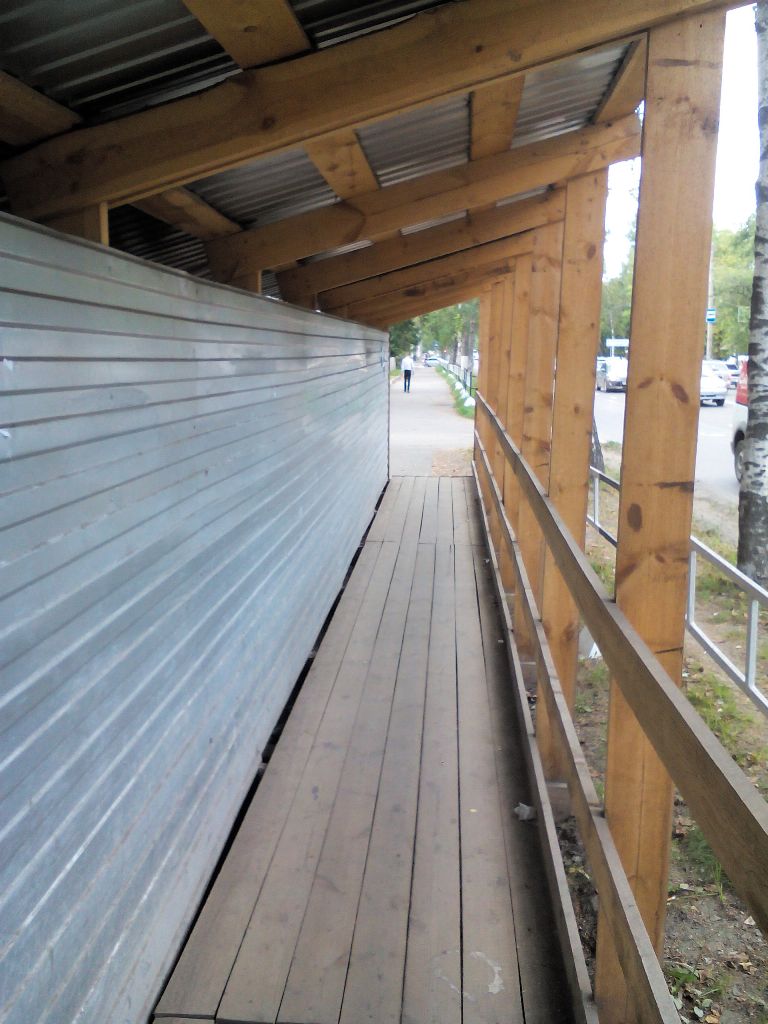
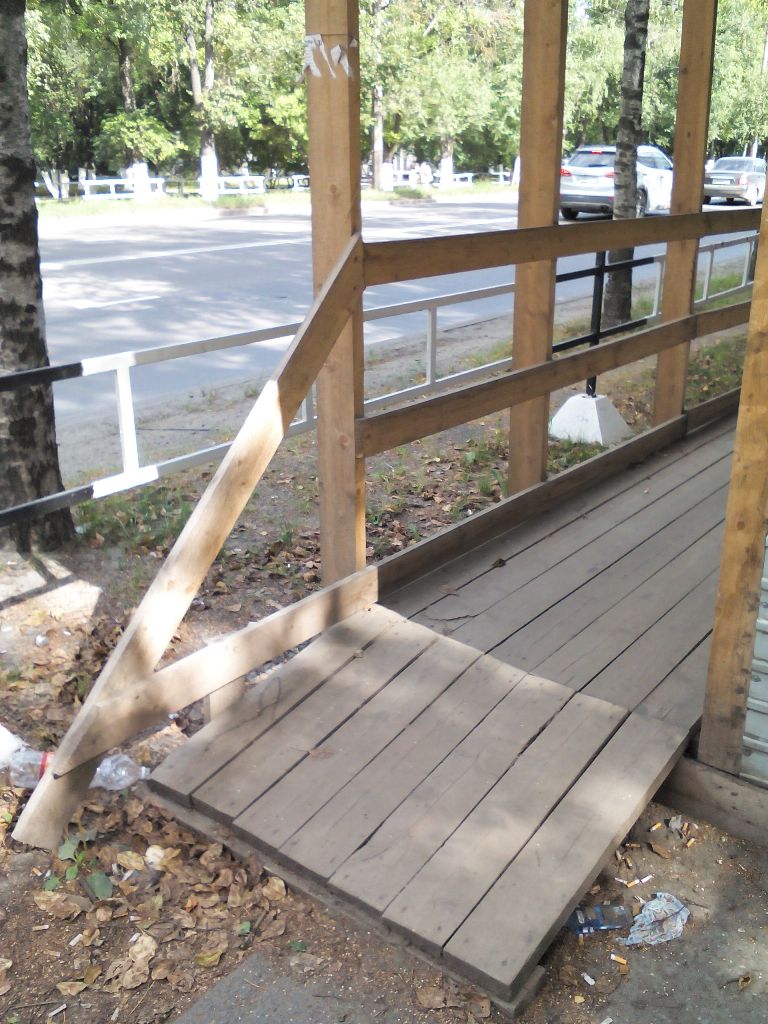


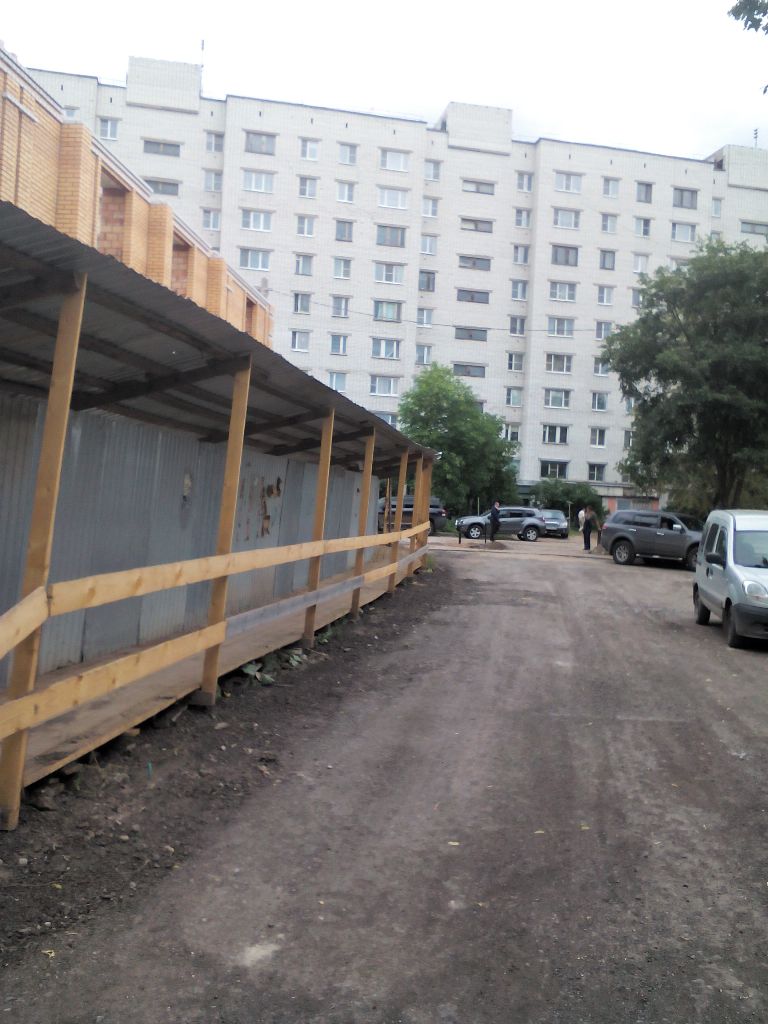
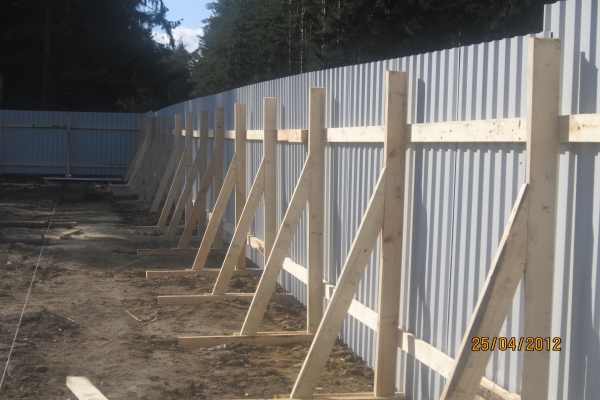
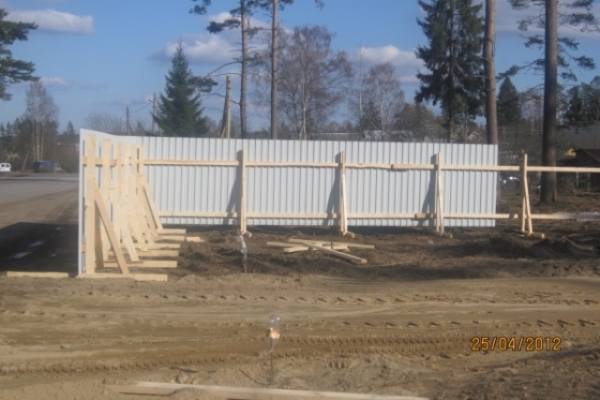


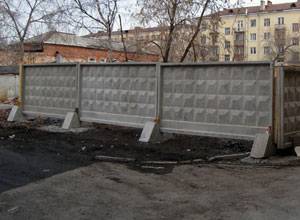
Fencing the construction site is a prerequisite for carrying out the relevant work on it. According to the current GOST and SNiPu, no brigade has the right to start construction without erecting a protective fence around the facility, since this structure is designed to fulfill a number of mandatory requirements. Namely:
- to regulate passers-by about the construction work;
- to protect the object from the penetration of unauthorized persons into its territory;
- prevent injury to people not involved in the site.
Types of fences for construction sites:There are two main types of fencing used on construction sites. It:
- one-time fences;
- temporary fences.
By one-time fences, we mean fences that are erected once and, after putting the object into operation, are disassembled and then disposed of. Enterprises rarely use such designs, since they do not justify economic feasibility. Unlike the first, the second option is used on facilities much more often. Temporary fencing of the construction site is a collapsible section of fences that are easy to install and dismantle.
Construction site fencing made of corrugated board:
Of the large number of temporary fences used for the construction of a protective barrier on construction sites, galvanized and polymer structures made of corrugated board are especially popular. Relatively lightweight material is resistant to weather extremes, low cost and ease of installation and dismantling works. At the same time, it meets all the provisions of the current GOST 23407-78, which means it also meets the safety requirements.
Temporary building fences can be made from a frame based on a metal pipe, followed by filling the sections with corrugated sheets. And as their fundamental basis, concrete blocks, steel anchors or metal plates are used. An alternative to such support structures are pillars driven into the ground.


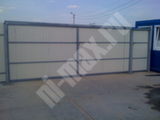
Construction site fencing GOST 23407-78: basic provisions
According to the main provisions of GOST 23407-78, when erecting a fence on a construction site, contractors must comply with the following rules:
- the structure of the fence must consist of collapsible elements of appropriate sizes;
- for the free movement of workers and construction equipment, the perimeter of the fence must have the required number of wickets and gates;
- the construction of the fence should provide for a place for people to move (pedestrian sidewalk), at least 1.2 m wide.
- it is desirable that signaling signs be located on the surfaces of the fences informing passers-by about the progress of construction;
- prefabricated panels must be made in the form of a rectangle with length parameters 1.2, 1.6 and 2 m.
- the height of the protective sections should be 1.2 m, and the protective and security sections - 2 m;
- the fence must withstand any weather conditions (squally wind, icing, snow, hail, etc.), as well as a drop of cargo from a height (200 kg per 1 cm2);
- along the perimeter, the structure should not have sharp, cutting edges and protrusions that could harm pedestrians.
The building fence is a prerequisite for carrying out work on the facilities being built. Its presence is to ensure the safety of passing people, protection from the entry of unauthorized persons into the territory and the prevention of accidents on the site. Depending on the type of object being built, the design of the fence is also determined - protective or protective and security.
Our company specializes in the manufacture of temporary fences for construction sites from corrugated board with their subsequent installation at attractive competitive prices. Specialists on an individual basis will be able to select a design that meets GOST according to the capabilities and requirements of each client. Having our own production workshop, purchasing materials from manufacturers allows us not only to reduce the cost of our products, but also to significantly improve their quality.
The construction site is a place of increased risk, since large-sized equipment is used there, heavy, sharp materials are used that can pose a danger to human health. Therefore, the area of construction, repair of the structure must be surrounded by a fence. According to the law, the presenceconstruction fencingtemporary type is required at all facilities prior to their commissioning.
What should be the temporary fence of the construction site, its functionality is regulated by two regulatory documents:
- "Organization of construction production" - the norms and rules of 1985 (SNiP 0.01.01-85);
- GOST 23407-78 dated 1979
According toSNiP 3.01.01-85, the construction site must be surrounded by a protective fence in order to comply with safety regulations.GOST23407-78 regulates the use of temporary barriers... The main provisions of the document:
- The construction of the structure cannot be started without the installation of a temporary fence of the construction site.
- The protective structure must be assembled / disassembled and made in the same style.
- In the fence, wickets and gates should be provided for the passage of people working at the facility, transport;
- The fence must be reliable and resistant to loads (precipitation, wind gusts, mechanical damage), withstand a weight of 200 kg / cm 2.
- The fence must be built from rectangular panels 1.2-2 m long, with a height of 1.2 m.
- Materials for the construction of the fence must have a quality certificate and a service life of at least 10 years.
- On the outside of the fence, a sidewalk with a width of at least 1.2 m should be arranged so that passers-by can move freely on it. It must be equipped with a protective canopy and handrail. The visor is built at an inclination of 20 ° so that it completely blocks the sidewalk and protects people passing there from precipitation, rainwater .
Important: according to the regulationsrequirements, the structure should not have sharp, traumatic parts.
Varieties of construction site fences
By design, fences around construction sites are:
- signaling - visually indicate the boundaries of the high-risk zone. They are represented by a special tape fixed between pins driven into the ground;
- protective - to avoid possible injury. These include the façade mesh that catches everything that falls from the scaffolding;
- security - the purpose of the installation of which is to prevent unauthorized persons from entering the construction site. They are fences made of various materials.
By the complexity of the construction of fencing construction sites can be:
- standard - simple structures in the form of a wall;
- with additional details - fences equipped with canopies, sidewalks, struts, railings.
Tip: If the construction is designed for a short time, the best option would be to install a standard fence, which will be inexpensive.
Structurally, building fences are distinguished:
- rack-mount - is a rack, fixed in the slabs of the roadway;
- panel - fences surrounding the construction site with a solid or sparse (mesh) wall;
- combined - are a combination of the two previous varieties.
Materials used for the manufacture of protective fences
Temporary construction site fences consist of:
- supports;
- frame;
- filling.
They can be made from:
- plastic;
- metal;
- wood;
- slate.
Note: the material for the construction of the protective fence must be of high quality and comply with the established standards.
Plastic
Thanks to modern technologies, the list of building materials has expanded. It includes plastic structures, from which you can also build a temporary fence for a construction site.
A plastic fence can be represented as a polymer mesh stretched between the poles. Thanks to its bright colors, it is noticeable on the ground, which contributes to the implementation of its signaling function.
Advice: steel wire will strengthen such a fence, threaded along its edges.
A popular temporary fencing is the construction of their plastic blocks, with polycarbonate sheets fixed at the top edges. Such a fence consists of type-setting sections, so its length can be changed.
Plastic fencing has the following advantages:
- resistance to the influence of factors environment... Plastic tolerates temperature changes well, it is not afraid of corrosion, high humidity;
- ease of installation. The material is lightweight, so one person can transfer and install products from it;
- ease of care. Plastics are given a certain color in the factory - products from it do not need additional painting, they are easy to wash;
- affordable price. Artificial material is cheaper than natural wood or metal.
Note: In accordance with current regulations, plastic fencing can be used. However, it cannot be used for large-scale construction, requiring the construction of continuous protective fences.
Wood
Wood attracts with its naturalness and affordable cost, but a building fence is erected from it only if the material is planned to be used in the future.
Mounting wooden fence is carried out quickly, but the structure must be additionally treated with antiseptic agents that will provide its protection from fire and decay. The cost of such a fence depends on the type of raw material, prices for impregnating compounds.
Metal
The simplest and most affordable type of temporary construction metal fencing is a chain-link mesh. It is easy to install, carry, and can be used many times. The installation of the mesh is carried out on a frame made of professional pipes and equal angles. But this material, like plastic, is not used in large-scale construction.
Inventory building fences are a more popular option. They are sections made of profiled mesh, allowing you to quickly build a temporary fence of arbitrary shape. The supports of these structures can be metal or concrete, which makes it possible to create enclosing structures of different stability.
The most expensive option for metal fencing for construction sites is the use of corrugated board. They are strong yet thin steel sheets having a protective polymer coating.
A fence made of a profiled sheet consists of supports and a frame, sheathed with metal shields. It has high strength, durability, resistance to moisture, unpretentious maintenance, easy to install.
Slate
A decade ago, temporary slate fences were common. But in modern conditions the material has lost its position in the construction market. It attracts with its affordable cost, easy installation, but is very fragile, prone to the formation of fungus, and has an unattractive appearance.
The choice of material for the construction of a temporary fence is carried out based on the specific situation. For large-scale construction, a reliable protective and protective fence (for example, from corrugated board) will be required. For small jobs, a plastic or mesh fence will suffice.
On a note: if the construction work is short-lived, you can not spend money on buying a fence, but rent it.
The device of a temporary fence allows you to secure the construction, avoid injury to people, accidents. It is necessary to approach the construction of a protective fence with all responsibility, to act in accordance with the established norms and rules, since neglect of them can threaten with serious consequences.
The assortment of the MasterTime company includes temporary construction fences. You can buy products of popular names by choosing accessories that are suitable for the type of use, configuration. The products are made by Russian manufacturers, therefore they are available.
Fencing of construction sites - types, relevance of use

According to current regulations, unfinished construction objects must be fenced around the perimeter. The need to install barrier structures at the first stage of work is regulated - already during site planning. At the same time, temporary fences of construction sites are used not so much to preserve property or building materials, but to prevent accidents.
Such areas pose a danger to passers-by who may accidentally find themselves in the immediate vicinity of a digging or unfinished structure, where work continues. Injuries are likely not only among accidental people, but also among the workers themselves. Therefore, construction site inventory fences represent a whole class of fixtures. And which of them to use, it is up to the group leader to decide.

The choice is great! And it contains both classic designs and new, improved ones. For some, building fences made of old slate are considered classics of the "genre", for others - wooden beams or metal sheets. All of them, especially if reused, found "somewhere" in order to save on costs, are certainly available. But they cannot be called convenient, because such fences for construction sites are extremely massive, complex and specific in transportation, overall and inconvenient to install. This increases their, at first glance, minimal cost, brings to the fore their irrationality.
Mesh structures are much lighter and more convenient. These are offered by the MasterTime company. Here you will find temporary fencing of the construction site, the price of which is the most favorable. And it is made of a metal profile, wire or plastic.
Protective construction fences from "Mastertime"
In our catalog you will find the following types of products:
- Portable fences are a metal frame made of a pipe with welded "legs". The middle part is made of thick wire or reinforcing bar. Portable construction fences are completely autonomous, can be used on any surface, and for installation they just need to be positioned in the required way. Their height is up to 1600 mm, which is enough to serve as a quality barrier. Also, the catalog contains a temporary portable plastic fence, smaller in size, with a lightweight design. All types of fixtures should be used within the construction site. Mobile fences can be bought to indicate the zone of excavation, the place of the excavation for the foundation, engineering networks. The protective structure will exclude accidents among workers at the construction site, will not allow falling into the pit. Its relevance increases if the work does not stop at night.
- Stationary systems - we offer for sale a metal chain-link and high-strength plastic nets, designed for the installation of barrier structures around the perimeter of the site. For installation, racks are used, and for a plastic mesh, these can be lightweight plastic posts, and fastening can be performed on polymer clamps. The classic chain-link is hung on metal supports and fastened with wire or welding. Mesh systems are lightweight, versatile, durable, and can be used repeatedly. In our catalog you will also find a PVC sheathed mesh, which combines the advantages of metal and plastic products: strength, corrosion resistance, low maintenance and visual appeal.
The price for the mobile temporary fences presented in the catalog in the MasterTime company is the most affordable. We offer a large assortment of them, high-quality and affordable designs.















 According to the main provisions of GOST 23407-78, when erecting a fence on a construction site, contractors must comply with the following rules:
According to the main provisions of GOST 23407-78, when erecting a fence on a construction site, contractors must comply with the following rules: 
